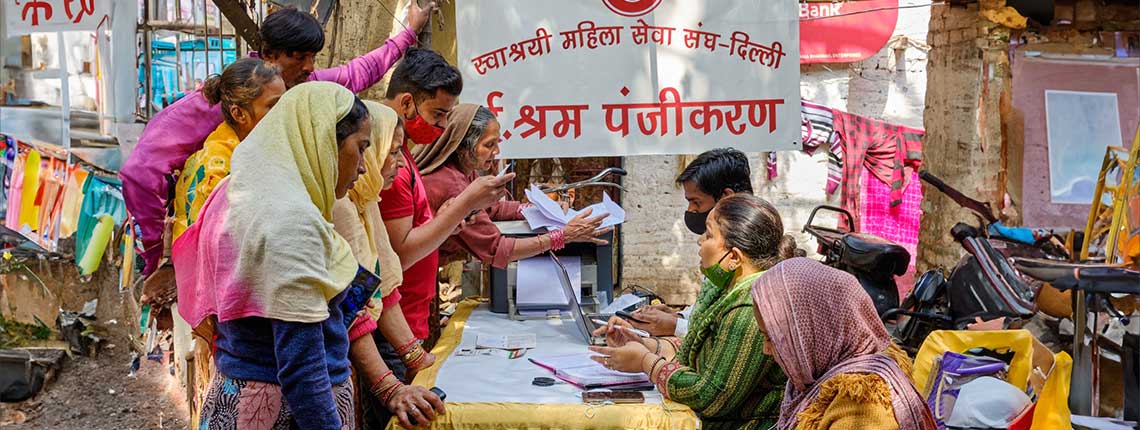
The COVID-19 pandemic laid bare the gaps in the social safety net and showed how most of the world’s workers – the 2 billion working in the informal economy – are being left behind. As the crisis evolved, many governments developed registries of workers in informal employment to facilitate the extension of protections to this “missing middle”: workers who neither receive social protection through work nor qualify for traditional cash transfer benefits.
E-Shram is a portal launched by the Indian Ministry of Labour and Employment in 2021 to create a national database of workers who earn a living in the informal economy. The portal aimed to seed the database with Aadhaar (a unique identity number) and use it to extend social security schemes to these workers. This national database includes various sectors and allows self-declaration of occupation without asking for documentary proof or declaration by the employer. The e-Shram cards issued after registration would hypothetically allow workers to access various benefits of the social security schemes anytime, anywhere across the country.
WIEGO’s Focal City Delhi team, working with grassroots organizations and partners in Delhi, facilitated over 13.000 registrations on the portal in 2021-2022. In the process of supporting our partner organizations in Delhi, we observed a range of challenges and opportunities related to the e-Shram system that hold lessons both for implementation going forward in India, and for governments in other countries interested in developing similar schemes.
Barriers to registration
When applying for the e-Shram card, the registration scheme requires an identification card, a bank account, and a functioning phone number. At least one link in that chain was broken for most workers in informal employment. This is of particular concern for migrant workers and women workers in India.
Many workers in informal employment are unfamiliar with technology. They do not have access to the internet, nor do they own smartphones. Data costs are unaffordable. This is particularly the case for women workers. Language is an additional barrier, as the site is only available in English and Hindi: many workers speak regional languages and some are not literate. Bridging these gaps requires digital literacy programs, multilingual support, and community outreach, which has not been provided as part of the process in India so far.
In addition, the technology was not robust enough to withstand high online traffic when registration opened and the e-Shram website would crash often – likely because it wasn’t prepared to deal with the volume of applications – creating a barrier to application. Although the web portal has since been made more robust, this initial barrier discouraged many from applying.
Also, the registration process requires selecting one's occupation from a list, which does not include many sectors of workers. Major categories of women’s employment, such as home-based work and waste segregation, are either absent or have been split into multiple different ones.
Collective efforts to fill the access gap and support registration
Civil society organizations – worker organizations, labour groups and trade unions – addressed many of these challenges and became a crucial link between the scheme and its beneficiaries in Delhi. Special initiatives to register workers were launched, including door-to-door campaigns to raise awareness about the potential benefits of the registry; the assistance of workers in navigating and fixing digital hurdles; facilitating bank and other entitlement linkages; and making registration desks available close to where workers lived or worked. The initiative also involved maintaining continuous communication and dialogue with the Ministry of Labour and Employment and Labor Department of Delhi, fostering an ongoing partnership aimed at refining the scheme and making it more worker-oriented.This was motivated by the belief that registration, enumeration and recognition are critical first steps in the long-term struggle for rights and protections.
As of September 2023, there have been 290 million registrations in India. In Delhi, largely due to efforts of civil society and worker organizations, over 3.2 million workers have been registered on the system. Just under 50% of those registered in Delhi are women. Unsurprisingly, 65% of those registered are between 18 and 40, suggesting easier access to the database for younger workers.
The objective of this social registry was to deliver social security and welfare benefits to workers in informal employment, migrant workers and women workers who previously had no access. While it has been successful in creating a data set of those workers - which did not exist before – and in creating a worker identity, it has not translated into any substantial new benefits.
The experience of e-Shram has varied across cities and states in India. In Delhi, many of the initial hiccups in e-Shram were addressed, but some larger issues remain. The need for an exhaustive list of informal occupations, especially women-dominated sectors, such as home-based workers, still remains to be addressed. Getting Adhaar cards and bank accounts linked with the scheme is still another major barrier, and holding localized camps for facilitating bank linkages and for making or updating the required documentation should run alongside the registration. Similarly, while the digital nature of the data makes it portable and, therefore, conducive to the delivery of benefits to migrant workers, no steps have been taken to ensure this delivery becomes a reality. Instead, there are concerns about data privacy and misuse. But most of all, there is an urgent need to link the e-Shram registrations with real benefits.
Lessons for rolling out registration systems beyond India
The Delhi experience holds key lessons for other governments attempting to roll out social protection through digital registries.
- If the point of a digital registry is to extend social protection to populations that have been historically excluded, questions of accessibility and inclusion must be taken seriously.
- Documentation requirements for identity verification need to be simple and multiple.
- Awareness-raising and community outreach must be built into the design of the registry.
- The role of labour organizations in assisting workers in accessing these services needs to be institutionalized, as their involvement has proven crucial to the process in India.
- Registries should be accessible in local languages and in a way that is clear and non-technical.
- In many countries, digital services are weakest among the working poor. If this segment is to be onboarded through the registration process, it is prudent to have both digital and offline modes of registration available.
- Most importantly, the e-Shram registration, like any other registry of workers, is, at best, a stepping stone to universal rights-based social protection. The registry process needs to be accompanied by an architecture of comprehensive social protection cover, including the financing of it, for the poor. Without it, the database remains merely an empty gesture.
Listen to more background on e-Shram in the WIEGO Social Protection podcast
Top photo: Community mobilizers from SEWA Delhi are assisting workers in informal employment in Delhi to register for the e-Shram scheme. Credit: SEWA Delhi
Related Posts
-
Informal Economy Theme
-
Informal Economy Topic
-
Occupational group
-
Language
